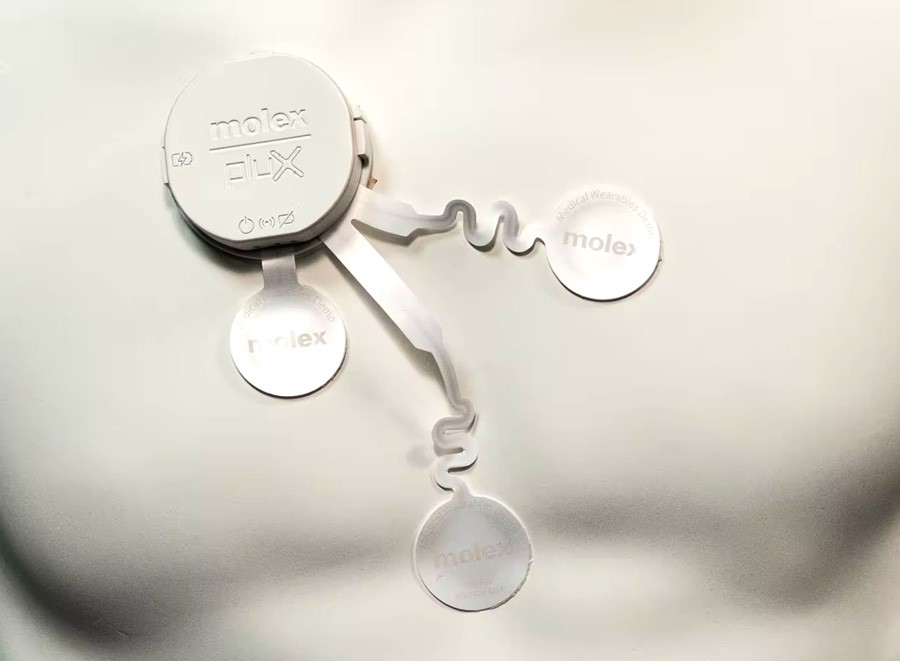Smart skin patches and non-invasive medical sensing
Today's smart skin patches can incorporate a broad range of functions, employing hybrid printed electronics to enhance medical sensing capabilities and improve patient outcomes. Along with the enormous potential, though, there are also complex design challenges.
Wladimir Punt, European Business Manager, Molex further explores.
The advance of electronics miniaturisation is opening new frontiers in medtech, including in the field of adhesive skin patches. In the past, a skin patch might contain a single wired sensor. But today’s smart skin patches incorporate a broader range of functions. Hybrid printed electronics permit a variety of electronic devices and non-invasive sensors to be affixed to a thin and flexible substrate, enabling designers to integrate sensors, microcontrollers, wireless connectivity, and batteries into a capable, durable, and connected device.
Whether in a clinical or home setting, this enables far more comprehensive patient monitoring. Adding enhanced capabilities to lightweight and flexible skin patches allows patients to go about their day while they (or their healthcare provider) monitor vital signs or activity noninvasively. There is tremendous potential for this flexibility to improve patient monitoring and make it simpler, more comfortable, and more accessible.
The evolving need for connected medical sensing
The demand for mobile, connected, and non-invasive medical sensing capabilities is growing. During the COVID-19 pandemic, the need for hospitals and clinics to monitor patients remotely became clear. This capability did more than allow doctors to track their patients’ vital signs while maintaining social distancing – it also helped address hospital overcrowding and assisted in alleviating staffing issues. Smart skin patches have emerged as a lightweight, comfortable, and portable method of monitoring patients both inside and outside a healthcare facility.
The market for home health monitoring is flourishing as well. With smart skin patches, home users can monitor their heart activity, temperature, and muscle health. These devices can be used for monitoring sleep and brainwave activity, making the low profile and light weight nature of smart skin patches especially helpful. Skin patches are increasingly popular for femtech applications such as pregnancy monitoring as well.
Smart skin patches all use flexible printed circuit technology and safe skin contacting adhesive, but their design architecture varies depending on the application. Each skin patch design is customised and, depending on the need, can be disposable or reusable. Disposable and one-time-use skin patches have a flexible substrate, usually polyethylene terephthalate (PET), with the electronics affixed directly to the substrate. In reusable patches, the electronics are mounted inside a removable ‘puck’ housing that mechanically and electrically connects to the substrate. The electronic components are reusable and only the electrodes in contact with the skin are disposable, reducing waste. This can, however, add logistics challenges and costs for the refurbishing process in some cases.

Opportunities and challenges of smart skin patches
Designers of monitoring systems can leverage a wide range of smart skin patch feature options. The skin patch can include various types of electronic devices. One or more sensors can be fitted, including temperature sensors, chemical sensors, electrodes, and even optical sensors. The skin patch can also include a battery, a microcontroller, and a radio frequency (RF) antenna to maintain a wireless connection to the network.
These are the physical building blocks of the system, and to achieve a specific purpose designers can mix, match, and customise them to meet performance targets. Different combinations of sensors and other devices can work with sophisticated software to noninvasively paint a picture of a patient’s condition or vital signs.
Sounds simple, right? Alas, system reliability requires several different engineering disciplines. For example, material science is vital to ensure the substrate can accommodate the expected wear, yet also provide a secure anchor for the electronic components. The type of conductive paste and hydrogel must meet the system’s requirements for manufacturability, shelf life and performance. Electronic components need to operate reliably during the expected lifetime of the product. Robust testing and validation are necessary to ensure product performance and support regulatory compliance.
From concept to production
Creating a smart skin patch means assembling multiple puzzle pieces to create a complete system. Collaborating with a company with decades of experience in this field is crucial. At Molex, several engineering disciplines work together to achieve a unified goal:
- Hybrid printed electronics design
- Material science
- Wireless connectivity
- Sensor integration
- Prototyping
- Testing and validation
- Production
- Packaging
Involving Molex engineers from the earliest stages of the design process helps ensure the product meets performance specifications and manufacturing requirements. In addition to engineering expertise, Molex also offers global manufacturing capabilities to reduce supply chain risks and speed time to market.
The need for smart skin patches to improve patient wellness and outcomes is enormous and continues to grow. Our medical expertise and collaborative design approach coupled with our diversified supply chain, high-volume production capabilities and regulatory compliance experience (including ISO 13485 standards) enables Molex to support development of innovative skin patches that improve lives.



